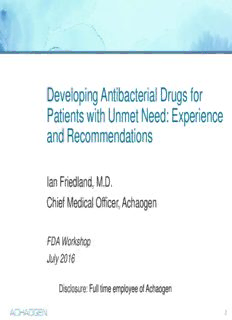
Friedland, I. Developing Antibacterial Drugs for Patients with Unmet Need PDF
Preview Friedland, I. Developing Antibacterial Drugs for Patients with Unmet Need
Developing Antibacterial Drugs for Patients with Unmet Need: Experience and Recommendations Ian Friedland, M.D. Chief Medical Officer, Achaogen FDA Workshop July 2016 Disclosure: Full time employee of Achaogen 0 Achaogen’s Position • Infeasible to conduct fully powered trials given low number of enrollable patients • Studies conducted in patients with unmet need provide critical data for clinicians • Smaller datasets provide highly descriptive information for prescribers and can support exposure/response analyses • Imperative that data in the unmet need population, including outcomes, is integrated into the product label 1 Standard Indications Do Not Address Unmet Need Differences in Patient Populations are Profound Standard Study Unmet Need Study cUTI/AP BSI, HABP/VABP due to CRE Unmet Need No Yes Few co-morbidities Significant co-morbidities Patient Low mortality High mortality Population No need for organ support Need for organ support Duration of ≤ 7 days 7 to 14 days Therapy Usual resistance All MDR Pathogens ~20% ESBLs, Few CRE Some XDR or PDR Polymicrobial infections rare Polymicrobial infections common Less predictable Similar to healthy volunteers More variable PK Mildly increased V d Significantly increased V d Adequate coverage may Combination Single agent data only require use of combination Rx therapy 2 Plazomicin is a New Aminoglycoside with Broad Enterobacteriaceae Activity Including CRE In vitro Activity vs. Clinical Isolates of CRE MIC MIC Compound Class N 50 90 (µg/ml) (µg/ml) Plazomicin Aminoglycoside 983 0.5 2 Gentamicin Aminoglycoside 978 4 >64 Amikacin Aminoglycoside 983 32 64 Ciprofloxacin Fluoroquinolone 822 8 8 Ceftazidime Cephalosporin 498 64 64 Penicillin/Beta- Piperacillin/tazobactam 756 >64 >64 lactamase inhibitor Tigecycline Glycylcycline 804 1 4 Colistin/polymyxin B Polymyxin 877 1 8 Susceptible Non-Susceptible Data from 1) J Chemother 2012;24:191-4, 2) J Antimicrob Chemother 2011;66:48-53, 3) J Antimicrob Chemother 2010;65:2123-7, 4), Antimicrob Agents Chemother 2009;53:4504-7, 5) IDSA 2014:E-1168B, 6) l ECCMID 2014:P1682 3 EPIC (cUTI) Provides Basis for Registration, CARE Provides Critical Data in an Unmet Need Population 2016 2017 EPIC (cUTI) 2016 2H ‘17 LPI NDA Submission CARE (Unmet Need in CRE) Achaogen’s plazomicin program is funded in part with Federal funds from the Biomedical Advanced Research and Development Authority, Office of the Assistant Secretary for Preparedness and Response, Office of the Secretary, Department of Health and Human Services, under Contract No. HHSO100201000046C. 4 Original CARE Study Design Pathogen-specific, Randomized, Open-label, Superiority Originally Intended to be Registrational Phase 3 Study y t i l a Bloodstream Infection, VABP or Plazomicin rt o + Meropenem or Tigecycline nt m Ventilated HABP due to CRE i o e Stratification p s d u 1:1 (n = ~360) n a • Infection Type c E - • Duration of Empiric Therapy o 1 all Colistin y • APACHE II Score a + Meropenem or Tigecycline d 8 2 Superiority in 28d ACM Assumed 35% mortality in the Control Arm (Meta-Analysis) with 12% absolute reduction with plazomicin 70% Power One-sided alpha of 0.05 286 pts with proven CRE Total N of 360 (evaluability of 80%) 5 Feasibility Assessment Suggested 3 Years of Enrollment to Reach 360 Patients Country No. sites CRO Projected No. Pts recommended Enrollment per year (pts/site/yr) Germany 5 1.2 6.0 Greece 10 1.4 14.4 Israel 5 2.4 12.0 Poland 7 1.3 10.9 Russia 11 1.8 19.8 Spain 7 1.8 12.6 Ukraine 6 0.9 5.8 Brazil 12 2.4 28.8 USA 5 0.9 4.8 TOTAL 68 Avg: 1.32 115 6 Enrollment Significantly Lower Than Projections Early Metrics in CARE Major Reasons for Prescreen 659 Prescreened Failure (~50%) • Pathogen is not CRE • >72 hrs empiric therapy Additional Reasons • Lack of consent • Polymicrobial infection • APACHE II Score <15 14 Enrolled • Emerging colistin resistance 7 Enrollment Challenges Experience from One Hospital in Greece • 17 patients with CR-Klebsiella in 4 month period • None from ICU • 2 patients were enrolled • Reasons for exclusion – 7 patients had APACHE II score < 15 – 4 isolates were resistant to colistin – 2 refused consent – 1 patient terminal – 1 concomitant BSI with A. baumannii 8 Two Amendments Designed to Boost Enrollment While Maintaining Potential for Superiority Cohort 1: BSI, HABP or VABP Plazomicin s Presumed or Documented CRE t: or e- on Restricted Eligibility + Meropenem or Tigecycline oin 28 eas cati p D s i • APACHE II < 15 1:1 N~360 nd at Di mpl • Known colistin resistance E y nt o y t a C • Polymicrobial infection ar ali ic d m rt nif e ts • Need prohibited antibiotics + MeropenCeomli sotrin T igecycline Pri Mo Sig elat poin R d n E y r a d n Cohort 2: BSI, HABP, VABP, cUTI or AP o c e S Presumed or Documented CRE BSI/HABP/VABP: Plazomicin + Broader Eligibility any suppl. antibiotic (N~50) • cUTI or AP • APACHE II ≤ 30 cUTI/AP: Plazomicin monoRx. • Known colistin resistance +/- oral switch (N~50) • Polymicrobial infection Patients can only enroll in cohort 2 if they are not eligible for cohort 1 9
Description: